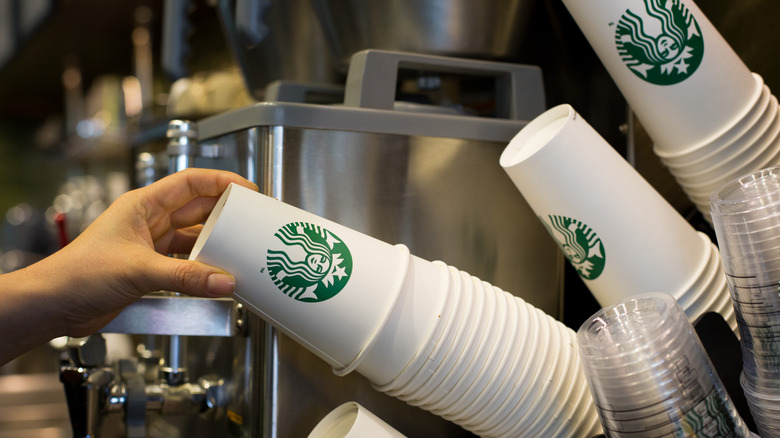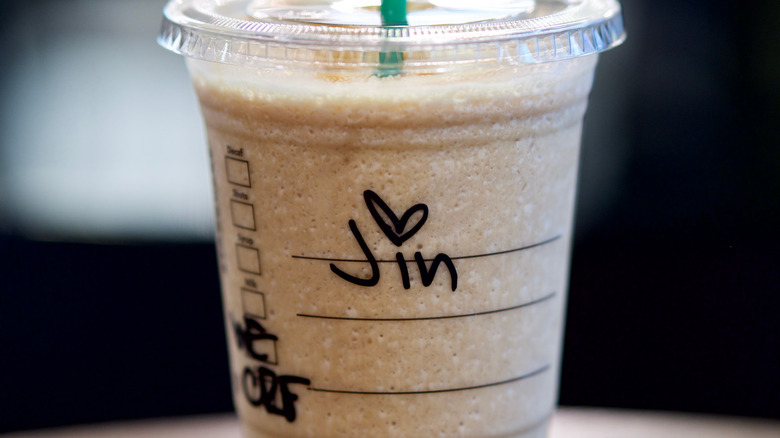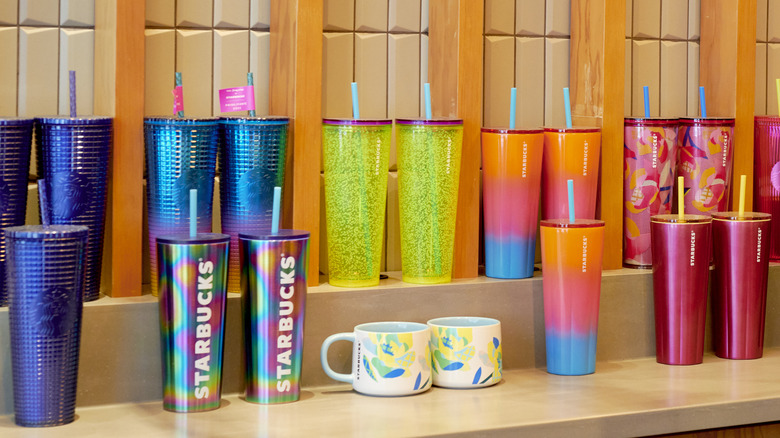Before Sharpies, Starbucks Had A Strange Code To Mark Custom Drinks
When you pick up your Starbucks drink, your cup is likely adorned with a small print-out tag that denotes your drink order, any customizations you've asked for, and your name. This is the most modern way that Starbucks keeps track of drink orders, though baristas at some stores still write customers' names on cups with a Sharpie marker, as well as noting down any modifications. One drink-labeling method that actually has been completely phased out is far more cryptic.
Before the advent of Sharpie labels and printed-out tags, a secret code was used by Starbucks workers to communicate drink orders to baristas. Cashiers would place customers' cups in specific positions on the counter to send their coworkers messages. The meaning of certain cup positions varied from store to store. If the logo on the cup was facing the barista, that could have meant the drink should use whole milk. If the logo faced away from the barista, the indication might be to use nonfat milk. Meanwhile, cups that were upside down or on their side could mean that the customer requested decaf.
If you're wondering how this simple system accommodated the endless number of drinks and customizations available at Starbucks, that's because the coffee chain's menu was once miniscule compared to what it is today. Menu expansion is what caused the company to seek new solutions.
When Starbucks menus grew, so did the need for ink
By the early 1990s, Starbucks stores were springing up across America at an eye-popping pace. Drink menus grew, as well, and the whole cup-positioning system became less than efficient (plus, can you imagine if rows upon rows of cups fell down while a sea of people were waiting for their drinks?). By the mid 90's, employees began to use Sharpies to keep track of customers' drink orders.
The check boxes printed on Starbucks cups go in tandem with Sharpie labels. These boxes, labeled with markers such as "shots," "syrup," and "milk," are used to denote order customizations. Cashiers write one- to three-letter drink codes (such as a capital B) to note down if you've asked for extra syrup, plant-based milk, and more. Even though many stores have graduated to using computer-printed drink labels, you'll still see these check boxes on the sides of disposable cups.
By 2012, baristas were writing customers' names on cups, and would simply call out each name when drinks were complete, so patrons could pick up their orders. At the same time, baristas themselves began wearing name tags on their aprons. This was done in an effort to get customers and baristas on a first-name basis to encourage familiarity and, ultimately, return visits. While name tags will almost certainly stick around for Starbucks' future, labels — even the modern printed ones — could be on their way out sooner than you think.
Starbucks stores might let go of their labels entirely
While digital printout labels are undoubtedly efficient, Starbucks is moving in a direction that might make current labeling methods entirely moot. The company hopes to phase out disposable paper and plastic cups completely by the year 2030 in a move to reduce its environmental footprint. In the future, customers will need to get into the practice of bringing their own reusable cups to their local store. Or, they can enjoy their drinks from reusable mugs and cups, if they sit down to enjoy their beverage in-store.
Starbucks is already encouraging patrons to bring reusable cups, launching a BYO cup system across the U.S. and Canada in early 2024. Customers who place an order on-site, at the drive-thru, or on the Starbucks app can opt to receive their drinks in their own clean cups when they arrive. All they need to do is notify the barista that they brought their own cup (or indicate it on the app) and hand it over without a lid or cover.
Baristas create BYO cup drinks using tools specifically designed for this purpose, so that ingredient ratios are still correct, despite the varying sizes and volumes of different cups. Starbucks currently offers a $0.10 discount and 25 Bonus Stars on its rewards program to those who take advantage of this new Sharpie-free practice. It looks like giving up on in-store labels altogether is a very real possibility for the company's future.



